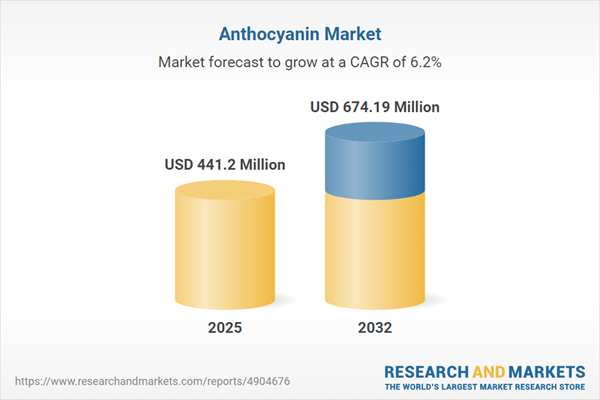Speak directly to the analyst to clarify any post sales queries you may have.
The anthocyanin market is rapidly evolving as industries intensify the shift toward natural colorants and functional ingredients. Senior leaders seeking to align product innovation with consumer health priorities are finding anthocyanins increasingly integral across verticals, including food, beverage, cosmetics, and nutraceuticals. The receptiveness of global supply chains and technology pipelines further underscores anthocyanin’s relevance for organizations pursuing sustainable portfolio transformation.
Market Snapshot: Strategically Assessing Anthocyanin Market Performance
The Anthocyanin Market grew from USD 415.46 million in 2024 to USD 441.20 million in 2025. This sector is forecast to expand at a CAGR of 6.23%, expecting to reach USD 674.19 million by 2032. Global adoption reflects positive momentum as stakeholders prioritize natural additive alternatives and functional enhancements, especially in segments where product differentiation is vital for competitiveness and compliance.
Scope & Segmentation of the Anthocyanin Market
This report delivers a detailed analysis of the anthocyanin landscape, mapping emerging opportunities for stakeholders across comprehensive segmentation lines. Each segment reflects shifting demands, investment priorities, and technological advancements:
- Sources: Black rice, blueberry, elderberry, grape — Each source offers distinct phytochemical profiles and supply considerations, influencing extraction approaches and end-use suitability.
- Forms: Liquid formats (concentrates, syrups), as well as powders (freeze-dried, spray-dried) — These forms address formulation flexibility, shelf-life requirements, and operational efficiency across product categories.
- Product Types: Natural anthocyanins and synthetic anthocyanins — Selection between these types impacts regulatory approvals and market positioning in increasingly clean label-oriented sectors.
- Distribution Channels: Offline and online — Channel strategy influences market reach, traceability, and customer engagement, as digital commerce and direct sourcing expand in B2B contexts.
- Applications: Animal feed (aquaculture, livestock, pet feed, poultry), cosmetics (color cosmetics, haircare, skincare), food and beverages (bakery, beverages, confectionery, dairy products, snacks), nutraceuticals (capsules, gummies, powders, tablets) — The relevance across these diverse applications supports risk diversification and portfolio extension for manufacturers and suppliers.
- Regions: Americas, Europe, Middle East & Africa, Asia-Pacific — Coverage includes high-consumption markets and emerging economies, encompassing regional dynamics around regulatory trends, consumer acceptance, and supply chain investments.
- Companies: Sensient Technologies Corporation, Symrise AG, Syngenta AG, Synthite Industries Pvt. Ltd., Vinayak Ingredients India Pvt. Ltd., DuPont de Nemours, Inc., Döhler GmbH, Evonik Industries AG, FMC Corporation, Archer-Daniels-Midland Company — These organizations represent sector leadership and innovation benchmarks.
Key Takeaways for Senior Decision-Makers
- Market leaders are investing in advanced extraction and purification technologies to enhance yield and sustainability, supporting long-term cost management and resource efficiency in production workflows.
- Consumer preferences now favor multifunctional ingredients, encouraging the rapid development of anthocyanin-enriched foods, beverages, and skincare products that deliver both visual appeal and perceived health value.
- Regulatory frameworks are evolving in key regions to streamline approval processes for natural colorants, promoting greater uptake and implementation of novel extraction and formulation technologies across industries.
- Agility in supply chain operations is central, with companies diversifying sourcing strategies, forming robust partnerships, and employing traceability systems to ensure resilience and product integrity throughout the value chain.
- Collaboration with research institutions and integration of digital quality management solutions facilitate robust innovation pipelines, enabling faster response to shifts in technology standards, regulations, and market demand.
Anthocyanin Market: Tariff Impact
With new United States tariffs taking effect from 2025, anthocyanin sector cost structures and procurement models are being reassessed. Increased import duties on raw materials, such as black rice extracts and fruit derivatives, are driving domestic manufacturers to evaluate alternative sourcing options, pursue local cultivation projects, and renegotiate supply contracts. Flexible pricing models and tariff engineering are emerging as key tools for companies seeking to maintain operational agility and supply chain resilience under new trade conditions.
Methodology & Data Sources
This research utilizes a mixed-method approach, drawing from scientific publications, regulatory filings, patents, and industry white papers. Structured interviews with key decision-makers, combined with targeted surveys, provide demand-side insight, while expert review ensures validation of major trends and sector priorities.
Why This Report Matters
- Access actionable insights into product and process innovation trends, enabling informed strategic decisions on technology investment, sourcing, and diversification.
- Utilize granular segmentation and qualitative scenario modeling to support risk assessment and long-term growth planning for regional and global market entry.
- Stay ahead of emerging regulatory shifts and competitive dynamics to protect enterprise value across volatile supply chains and changing consumer expectations.
Conclusion
This report provides senior stakeholders with the strategic clarity needed to build resilience and capture opportunity within the global anthocyanin value chain. These insights support informed investment and operational decisions for sustainable growth in an evolving marketplace.
Additional Product Information:
- Purchase of this report includes 1 year online access with quarterly updates.
- This report can be updated on request. Please contact our Customer Experience team using the Ask a Question widget on our website.
Table of Contents
3. Executive Summary
4. Market Overview
7. Cumulative Impact of Artificial Intelligence 2025
List of Figures
Samples

LOADING...
Companies Mentioned
The key companies profiled in this Anthocyanin market report include:- Sensient Technologies Corporation
- Symrise AG
- Syngenta AG
- Synthite Industries Pvt. Ltd.
- Vinayak Ingredients India Pvt. Ltd.
- DuPont de Nemours, Inc.
- Döhler GmbH
- Evonik Industries AG
- FMC Corporation
- Archer-Daniels-Midland Company
Table Information
| Report Attribute | Details |
|---|---|
| No. of Pages | 192 |
| Published | October 2025 |
| Forecast Period | 2025 - 2032 |
| Estimated Market Value ( USD | $ 441.2 Million |
| Forecasted Market Value ( USD | $ 674.19 Million |
| Compound Annual Growth Rate | 6.2% |
| Regions Covered | Global |
| No. of Companies Mentioned | 11 |









